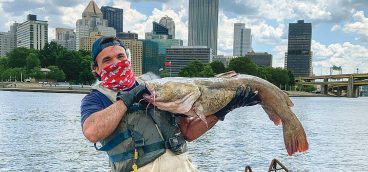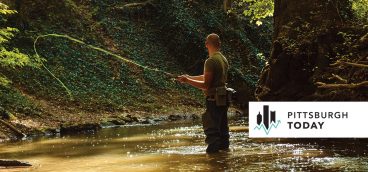
Like everyone else who saw the “Lord of the Rings” film trilogy, I was somewhat stunned by the dramatic beauty of New Zealand. But I’d never seriously considered visiting until Christmas 2014, when my oldest son was home from Shanghai and said, “Let’s go fly-fishing together in New Zealand.” I’ve always loved fishing, but not so my son, despite or perhaps because of my constant entreaties to go fishing with me. So if he was asking, I was going.
However, I don’t love flying, and New Zealand is about as far away from Pittsburgh as you can fly. And after 13 nonstop hours from San Francisco over nothing but the Pacific, it feels like it. The long, thin country (smaller than Kentucky) comprises the North and South islands and stretches almost 1,000 miles north-northeast. It sits astride two enormous tectonic plates that grind against each other, causing volcanoes and massive earthquakes, like the series that devastated the South Island’s main city, Christchurch, in 2010 and 2011. We spent what was left of our first afternoon in once-beautiful Christchurch, where continual delays are depressing a city that saw one-third of its buildings demolished.
At 6 a.m. the next morning, we met Chris Bell, our friendly young fishing guide. Driving out of the city, Chris kept talking about “Crushage.” It took some time to figure out that he was saying Christchurch, and we had fun with the language the rest of the trip. I picked Chris because he was also a naturalist who understands geology and the local flora and fauna.
Zane Grey made New Zealand fishing famous in his 1926 “Tales of the Angler’s Eldorado,” and that’s what it is—a land of rainbow and brown trout that grow to enormous sizes because they feed all year. The fish are so big they actually eat mammals. As Chris told us, this year was what’s called a “mouse year” or “mast year” because the mountain beech trees dropped a huge quantity of seeds, causing an explosion in the number of mice. And when the mice cross the streams and rivers, the giant trout devour them.
New Zealand fishing is more like hunting. Though the fish are huge, they’re easily spooked. And on a small stream, the “gin clear” water means you have to hide behind brush and crawl to the banks, casting your fly while out of sight. Getting to the spots was half the fun (and work), hiking miles through magnificent mountain scenery to reach the waters. One added bonus to trekking through New Zealand’s wilds is that, compared with the American West, you don’t have to worry about grizzlies or anything threatening—not even snakes. You can’t find a more benign environment. Or so I thought…
The only animal locals disparage is the possum. New Zealanders hate possums. They shoot them, poison them and swerve to run them over on the road. “Why?” I asked Chris. First of all, he said, they’re Australian imports, and the 30 million possums eat native plants and kill birds. I still couldn’t understand how the little pink-and-white creatures, so pathetic that they play dead at any threat, could stir such passion.
After a great first day fishing, we stayed in a lovely little fishing hut, and in the middle of the night as I walked through the dark to the little kitchen to rehydrate, something heavy fell on my head and raked across my cheek. I checked if a ceiling tile had fallen, but nothing was on the floor. Feeling my bleeding cheek, I said, “What in the %#$& was that?!”
I noticed the wind had blown the front door open, and in the back room a black creature the size of a giant house cat paced back and forth. Chris appeared, chased it out and said, “That’s a New Zealand possum.” I was left a wiser, weaker man, with a bandaged face and the ignominy of being the only person I know who’s been attacked and bloodied by a possum. But I had seen the light. Kiwi possums are different from the opossum we call by the same name. And I vowed that if I ever saw another on our trip, I would… run!
* * *
We drove all over both islands, putting 2,000 miles on the car in two weeks. That sounds like a lot, and it was, but the magnificent sights made it a joy. The two-lane highways, however, are narrow and generally without shoulders, which can be hairy on winding mountain roads when tour buses barrel past. We were there in late February during Chinese New Year, and while New Zealand is closely tied to the Chinese economy and is a favorite among Chinese tourists, the South Island buzzed with front-page reports of bad Chinese drivers, including one who crossed the center line and killed a 5-year-old local girl. One South Islander was so angry at another Chinese driver that he took his keys and threw them over a cliff.
The entire country is scenic, but the most beautiful drive is Te Anau to Milford Sound, winding around and through mountains, along gorgeous rivers, and into rainforests with magnificent trees and hanging moss. You don’t want to hurry this drive—there’s nothing like it. We stopped to fish and to walk the beautifully maintained trails. Unlike any country I’ve visited, New Zealand is for walkers and hikers. (We would later spend a day walking 10 miles on the Abel Tasman Track, climbing from the beach along a ridge with spectacular views.)
Milford Sound has been judged the top travel destination in the world, and the steep, dark and creepy Homer tunnel is a memorable front door, after which you descend 3,100 feet in about 10 minutes. Our destination was an overnight cruise through the Sound. Often in the company of dolphins, the ship cruises the 10-mile length of the misty sound to the mouth of the Tasman Sea, a hangout for seals and great white sharks. Food, drinks, international company and mountains coming down to the water all around you make an unforgettable afternoon and evening.
“I was left a wiser, weaker man, with a bandaged face and the ignominy of being the only person I know who’s been attacked and bloodied by a possum.”
The fun capital of the South Island is Queenstown, a vacation paradise with bars, restaurants, nightlife and the well-deserved title of “Adventure Capital of the World.” We passed on bungee jumping, skydiving, and parasailing in favor of an exhilarating jet boat ride through the Shotover River Canyon. This amounts to high-speed skimming over a shallow river and barely missing the jagged granite walls. Not for the faint of heart, but gorgeous and great fun.
To lower my pulse rate, that evening we boarded the 103-year-old Edwardian steamer TSS Earnslaw for a 90-minute cruise down Lake Wakatipu to Walter Peak Country Farm where an abundant, delicious dinner and sheep-shearing exhibition awaited. It was on the way back, under a clear night sky that we took in our first great view of the stars of the Southern hemisphere, including the Southern Cross. It’s no wonder billionaires are buying private airstrips and farms in New Zealand as a place to escape if a cataclysm comes to the U.S. In New Zealand, whose closest neighbors are Australia and Antarctica, it really feels as if you’re at the end of the earth. It was one of the last places on earth to be inhabited by people in the late 14th century, and maybe—like the old movie “On the Beach”—it’ll be the last place people remain.
* * *
When our nine days on the South Island were up, we boarded the car ferry to the North Island, crossing Cook’s Strait, square in the crosshairs of the “roaring 40s” where westerly winds whip across the southern globe, largely unbroken, creating one of the most dangerous and unpredictable seas in the world. Even on a huge ship, which we were, if you’re prone to motion sickness, down your Dramamine.
Everyone recommends at least two weeks in New Zealand, which we did, but three would be better. We had to give short shrift to the Maori culture and to the North Island, but three places we saw merit mention. Rotorua is the country’s geothermal capital with geysers, hot mud pools, mineral baths and a potent rotten-egg sulphur smell. If you’ve never been to Yellowstone, it’s worth seeing.
Lake Taupo is a major fishing destination and home to a vibrant lakefront restaurant scene. It’s also home to the five-star Huka Lodge, often rated one of the best in the world. On the banks of the beautiful Waikato River just upstream from dramatic Huka Falls, the 90-year-old retreat started as a fishing lodge, and its 20 rooms are nestled in 17 acres of nationally significant gardens. Arriving guests meet with the chef to determine their favorite foods, and the décor, service, food and wine provide the perfect tonic for travelers who’ve been on the go outdoors. Friends described it as “one of the most beautiful places they’d ever been,” and we agree.
Our last stop before flying out of Auckland was Matamata for “Hobbiton,” a movie set tour of the “Lord of the Rings” and “The Hobbit” trilogies. I figured it would be marginal, but my son wanted to go, and it was on our way to the airport.
While scouting the country in 1998, director Peter Jackson made a deal with the Alexander family to use their sheep farm as the tranquil setting of “The Shire” in the movies. The Alexanders agreed on the condition that the set be torn down in leave-no-trace fashion. The set for the first trilogy was relatively cheap and two-dimensional, but delays in the tear down meant the first movie came out before the set was gone. With the film being an enormous hit, visitors started appearing to see what remained of the set, and the Alexanders said “Hmm. Why don’t you just leave the rest of the set up.”
Years later when Jackson returned and asked to use the same land for “The Hobbit” trilogy, the Alexanders said yes, on one condition: that the Shire be reconstructed with real materials and that the set be left after filming finished. It took two years and an undisclosed amount to build, but the new Shire has become one of the country’s top tourist destinations with 350,000 visitors a year paying $75 (half that for kids).
The charming and detailed set has been such a tourism bonanza for the Alexanders, New Line Cinema and Jackson that the Alexanders later built a real life Green Dragon Pub at their own expense in exquisite detail and give all visitors either a mug of dark ale, amber ale, hard cider or non alcoholic ginger beer at the end of the tour. A pint in Middle Earth was the perfect way to end the trip.




